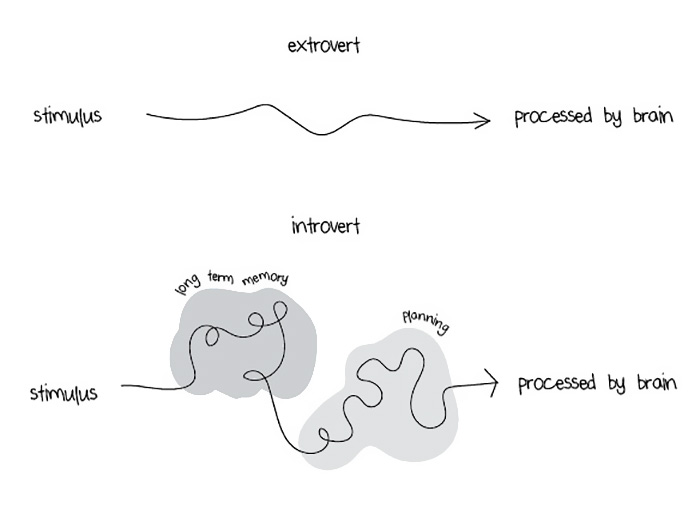
Made by Liz Fosslien and Mollie West, the following illustrations, which first appeared on Quietrev, perfectly encapsulate what it means to be an introvert. While introverts are often branded “antisocial” and “boring”, Many people probably don’t realize that being an introvert or an extrovert isn’t necessarily a behavioral choice. For example, studies have shown that an introvert’s brain processes information in an entirely different way to their social and outgoing opposites. Whereas extroverts process stimuli quickly, the neural pathway for handling information is longer for introverts and so it becomes harder for them to process information and events. Take a look at the illustrations below to see what we mean. You’ll never think about introverts in the same way again.
More info: Liz Fosslien | Mollie West
1. According to The Introvert Advantage by Marti Olsen Laney, introverts have a longer neural pathway for processing stimuli. Information runs through a pathway that is associated with long term memory and planning. In other words, it’s more complicated for introverts to process interactions and events. As they process information, introverts are carefully attending to their internal thoughts and feelings at the same time.

2. According to studies by psychologist Hans Eysenck, introverts require less stimulation from the world in order to be awake and alert than extroverts do. This means introverts are more easily over-stimulated.

3. The flip side of introverts’ sensitivity to dopamine is that they need less of it to feel happy. Extroverts’ brains run on an energy-spending nervous system, whereas introverts’ brains run on an energy-conserving nervous system. This is why introverts feel content and energized when reading a book, thinking deeply, or diving into their rich inner world of ideas.

4. Introverts’ brains aren’t as strongly rewarded for gambling or taking risks as extroverts’ brains are. The brain’s reward and pleasure system is activated by dopamine neurotransmitters. Scientists found that extroverts’ brains responded with more pleasure to positive gambling results. In other words, introverts feel less excitement from surprise or risk.

5. The introvert’s brain treats interactions with people at the same intensity level that it treats encounters with inanimate objects. Introverts process everything in their surroundings and pay attention to all the sensory details in the environment, not just the people.

6. As introverts are thinking, they reach back into long-term memory to locate information. An introvert will often compare old and new experiences when making a decision, which slows the processing down but leads to carefully thought-out decisions. This means that introverts have an active dialogue with themselves and usually walk around with many thoughts in their minds.

These illustrations first appeared on Quietrev.com
Source: Bored Panda
Related:
- 21 Insanely Useful Skills Every Introvert Has Mastered
- This 25 Question Test Will Determine Which Type Of Introvert You Are!
- 10 Characteristics Of An Extroverted Introvert
- 30 Hilarious Thoughts Every Introverted Person Goes Through
- The Life of An Introvert Described By 17 Different Graphs
- 55 Intriguing Quotes About Introverts And Lonewolves
- This Is How To Interact With The Introverted…
- 5 Things Everyone Should Know About Introverts
- 10 Things You Should Know Before You Date An Outgoing Introvert
- 14 Truths About Being An Introvert (That Mainly Introverts Will Understand)
- As I Began To Love Myself – Charlie Chaplin – A Beautiful Self Love Poem
- Loners Tend To Be More Intellectual And Loyal Friends
- Alone Isn’t Lonely: 10 Signs You’re Perfectly Happy With Solitude
- How To Be Alone Without Feeling Lonely















COMMENTS